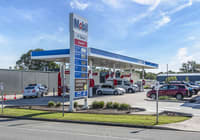
How to invest like a millionaire in commercial property – with $100k
The world’s wealthiest people have turned to commercial property investment as residential values rise and a growing number of younger investors with less capital to spend are increasingly picking up on the trend, too.
Commercial real estate investment in Australia rose by 57 per cent year-on-year and is the sixth most active global market, according to real estate agency Knight Frank’s Wealth Report 2025 published in March.
The wealth report reflects global spending habits of people with a net wealth of $US1 million ($1.5 million) or more and in Australia, 62 per cent of self-managed super funds with balances over $2 million had investments in commercial real estate in FY22 – up from 54 per cent in FY15 – according to the most recent Australian Taxation Office figures.

But people on lower incomes are increasingly turning to the commercial real estate investment class.
Oscar Ledlin is using Instagram to build a commercial property empire that put him in the Financial Review’s Young Rich List last year with an estimated wealth of $72 million.
Ledlin offers storage units to investors and owner-occupiers through his business Flexie from under $150,000.
“Twenty years ago, industrial was the ugly duckling of the commercial asset types, and then off the back of COVID, and the recent industrial property boom, it’s become almost a golden child of the commercial asset types,” he said.
“It’s been the most resilient. It’s had the most capital growth. It’s got the lowest vacancy rates of the commercial asset classes.”
The attraction of the warehouse and storage sector is clear in the $2.17-billion battle playing out at the institutional level between southern African billionaire Nathan Kirsh and ASX-listed National Storage REIT over the fate of spare-space provider Abacus Storage King.
But commercial storage was also accessible for individuals who could pool their money in syndicates to invest, said financial advisory Viola Wealth executive chair Charlie Viola.
“We’re big ones for diversity, we’re big ones for holding all different types of assets, but if I had $100,000 in my portfolio that had to go into property … I would buy commercial property over residential property every day,” he said.
Higher risk, bigger deposits, longer terms
The risks for investors of commercial property are higher than for residential. While assets such as storage units could be “cash-flow machines”, lease terms tended to be longer than for residential contracts, Viola said.
In addition, banks lent money on lower loan-to-value ratios, requiring investors to put up more capital up-front, he said.

But small investors were becoming increasingly familiar with it as the costs and obligations of residential investment increased, said Ingrid Filmer, the chief executive of commercial property auctioneer Burgess Rawson, which US-listed CBRE acquired last month.
“Commercial is not the big scary beast that I think maybe more traditional investors see it as,” Filmer said.
“As a result of onerous residential laws, there’s been a massive push into learning and understanding commercial, and the investors are flocking to it.”
In the types of assets sold at Burgess Rawson auctions – such as fast-food restaurants, service stations and convenience stores – banks typically require a 40 per cent deposit and commercial land values start above $1 million.
Filmer, however, said she was seeing people coming out of the residential market and into commercial, because the equity they had built up in their homes or investment properties was giving them capital to put into commercial.

Scott O’Neill, the head of commercial property buyers’ agency Rethink Investing, also said he was seeing an increase in first-time commercial property buyers due to better cash flow opportunities and a greater education around commercial investment.
“Rising residential prices have generated equity that many investors are now reallocating into commercial properties. At the same time, the residential market has become less affordable, making commercial properties a more attractive option than before,” O’Neill said.
“In 2025, the cash flow from residential properties in Australia is insufficient for a comfortable retirement.”
The average gross yield on residential investment of about 4 per cent fell further after the deduction of costs such as maintenance, interest costs, insurance, and vacancy periods, O’Neill said.
“Conversely, in commercial properties, tenants typically cover your outgoings, and the yields are generally higher,” he said.

“For example, we target commercial assets exceeding 6 per cent net.”
The resilience of commercial property was making more and more people pay attention to it, Ledlin said.
“It [commercial property] is definitely heading in the more retail, Mum-and-Dad investor direction,” he said.











